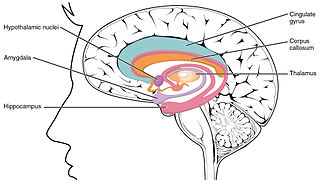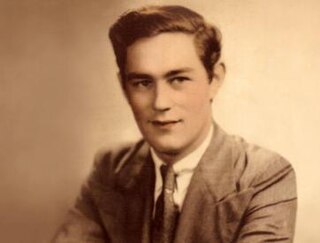Neuropsychology
Normal brain function
Hippocampus

Although many psychologists believe that the entire brain is involved with memory, the hippocampus, and surrounding structures appear to be most important in declarative memory specifically. [16] The ability to retain and recall episodic memories is highly dependent on the hippocampus, [16] whereas the formation of new declarative memories relies on both the hippocampus and the parahippocampus. [17] Other studies have found that the parahippocampal cortices were related to superior recognition memory. [17]
The Three Stage Model was developed by Eichenbaum, et al. (2001), and proposes that the hippocampus does three things with episodic memory:
- Mediates the recording of episodic memories
- Identifies common features between episodes
- Links these common episodes in a memory space.
To support this model, a version of Piaget's Transitive Inference Task was used to show that the hippocampus is in fact used as the memory space. [16]
When experiencing an event for the first time, a link is formed in the hippocampus allowing us to recall that event in the future. Separate links are also made for features related to that event. For example, when you meet someone new, a unique link is created for them. More links are then connected to that person's link so you can remember what colour their shirt was, what the weather was like when you met them, etc. Specific episodes are made easier to remember and recall by repeatedly exposing oneself to them (which strengthens the links in the memory space) allowing for faster retrieval when remembering. [16]
Hippocampal cells ( neurons ) are activated depending on what information one is exposed to at that moment. Some cells are specific to spatial information, certain stimuli (smells, etc.), or behaviours as has been shown in a Radial Maze Task. [16] It is therefore the hippocampus that allows us to recognize certain situations, environments, etc. as being either distinct or similar to others. However, the Three Stage Model does not incorporate the importance of other cortical structures in memory.
The anatomy of the hippocampus is largely conserved across mammals, and the role of these areas in declarative memory are conserved across species as well. The organization and neural pathways of the hippocampus are very similar in humans and other mammal species. In humans and other mammals, a cross-section of the hippocampus shows the dentate gyrus as well as the dense cell layers of the CA fields. The intrinsic connectivity of these areas are also conserved. [18]
Results from an experiment by Davachi, Mitchell, and Wagner (2003) and subsequent research (Davachi, 2006) shows that activation in the hippocampus during encoding is related to a subject's ability to recall prior events or later relational memories. These tests did not differentiate between individual test items later seen and those forgotten. [19] [20]
Prefrontal cortex
The lateral Prefrontal cortex (PFC) is essential for remembering contextual details of an experience rather than for memory formation. [17] The PFC is also more involved with episodic memory than semantic memory, although it does play a small role in semantics. [21]
Using PET studies and word stimuli, Endel Tulving found that remembering is an automatic process. [22] It is also well documented that a hemispheric asymmetry occurs in the PFC: When encoding memories, the Left Dorsolateral PFC (LPFC) is activated, and when retrieving memories, activation is seen in the Right Dorsolateral PFC (RPFC). [22]
Studies have also shown that the PFC is extremely involved with autonoetic consciousness (See Tulving's theory). [23] This is responsible for humans' recollective experiences and 'mental time travelling' abilities (characteristics of episodic memory).

Amygdala
The amygdala is believed to be involved in the encoding and retrieval of emotionally charged memories. Much of the evidence for this has come from research on a phenomenon known as flashbulb memories. These are instances in which memories of powerful emotional events are more highly detailed and enduring than regular memories (e.g. September 11 attacks, assassination of JFK). These memories have been linked to increased activation in the amygdala. [24] Recent studies of patients with damage to the amygdala suggest that it is involved in memory for general knowledge, and not for specific information. [25] [26]
Other structures involved
The regions of the diencephalon have shown brain activation when a remote memory is being recovered [21] and the occipital lobe, ventral temporal lobe, and fusiform gyrus all play a role in memory formation. [17]
Lesion studies
Lesion studies are commonly used in cognitive neuroscience research. Lesions can occur naturally through trauma or disease, or they can be surgically induced by researchers. In the study of declarative memory, the hippocampus and the amygdala are two structures frequently examined using this technique.
Hippocampal lesion studies

The Morris water navigation task tests spatial learning in rats. [27] In this test rats learn to escape from a pool by swimming toward a platform submerged just below the surface of the water. Visual cues that surround the pool (e.g. a chair or window) help the rat to locate the platform on subsequent trials. The rats' use of specific events, cues, and places are all forms of declarative memory. [28] Two groups of rats are observed: a control group with no lesions and an experimental group with hippocampal lesions. In this task created by Morris, rats are placed in the pool at the same position for 12 trials. Each trial is timed and the path taken by the rats is recorded. Rats with hippocampal lesions successfully learn to find the platform. If the starting point is moved, the rats with hippocampal lesions typically fail to locate the platform. The control rats, however, are able to find the platform using the cues acquired during the learning trials. [27] This demonstrates the involvement of the hippocampus in declarative memory. [28]
The Odor-odor Recognition Task, devised by Bunsey and Eichenbaum, involves a social encounter between two rats (a subject and a demonstrator). The demonstrator, after eating a specific type of food, interacts with the subject rat, who then smells the food odor on the other's breath. The experimenters then present the subject rat with a decision between two food options; the food previously eaten by the demonstrator, and a novel food. The researchers found that when there was no time delay, both control rats and rats with lesions chose the familiar food. After 24 hours, however, the rats with hippocampal lesions were just as likely to eat both types of food, while control rats chose the familiar food. [29] This can be attributed to the inability to form episodic memories due to lesions in the hippocampus. The effects of this study can be observed in humans with amnesia, indicating the role of the hippocampus in developing episodic memories that can be generalized to similar situations. [28]
Henry Molaison, previously known as H.M., had parts of both his left and right medial temporal lobes (hippocampi) removed which resulted in the loss of the ability to form new memories. [30] The long-term declarative memory was crucially affected when the structures from the medial temporal lobe were removed, including the ability to form new semantic knowledge and memories. [31] The dissociation in Molaison between the acquisition of declarative memory and other kinds of learning was seen initially in motor learning. [32] Molaison's declarative memory was not functioning, as was seen when Molaison completed the task of repetition priming.
His performance does improve over trials, however, his scores were inferior to those of control participants. [33] In the condition of Molaison the same results from this priming task are reflected when looking at the other basic memory functions like remembering, recall and recognizing. [30] Lesions should not be interpreted as an all-or-nothing condition, in the case of Molaison not all memory and recognition is lost, although the declarative memory is severely damaged he still has a sense of self and memories that were developed before the lesion occurred. [34]
Patient R.B. was another clinical case reinforcing the role of the hippocampus in declarative memory. After suffering an ischemic episode during a cardiac bypass operation, Patient R.B. awoke with a severe anterograde amnesic disorder. IQ and cognition were unaffected, but declarative memory deficits were observed (although not to the extent of that seen in Molaison). Upon death, an autopsy revealed that Patient R.B. had bilateral lesions of the CA1 cell region along the whole length of the hippocampus.
Amygdala lesion studies
Adolph, Cahill and Schul completed a study showing that emotional arousal facilitates the encoding of material into long term declarative memory. [35] They selected two subjects with bilateral damage to the amygdala, as well as six control subjects and six subjects with brain damage. All subjects were shown a series of twelve slides accompanied by a narrative. The slides varied in the degree to which they evoked emotion – slides 1 through 4 and slides 9 through 12 contain non-emotional content. Slides 5 through 8 contain emotional material, and the seventh slide contained the most emotionally arousing image and description (a picture of surgically repaired legs of a car crash victim). [35]
The emotionally arousing slide (slide 7) was remembered no better by the bilateral damage participants than any of the other slides. All other participants notably remembered the seventh slide the best and in most detail out of all the other slides. [35] This shows that the amygdala is necessary to facilitate encoding of declarative knowledge regarding emotionally arousing stimuli, but is not required for encoding knowledge of emotionally neutral stimuli. [36]








